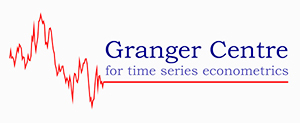
Research Theme 1: Non-Stationary Time Series Methods
This theme is at the core of the activities of the members of the Granger Centre and covers a number of projects concerned with modelling, testing and policy evaluation in macroeconomic and financial time series. Both theoretical and applied methodologies are central to this theme. Our research is focused on the following areas:
Unit Root and Cointegration Testing
Testing for the presence of non-stationary autoregressive unit root against the alternative of stationarity has been an issue at the core of econometric research for the last quarter century. Many important and challenging questions remain unresolved:
- Developing and applying methods and producing associated computer software for testing for unit roots when one is uncertain over the form of the deterministic component present in the data.
- Developing and applying and producing associated computer software for the computation of near-optimal tests for unit roots when there are structural changes in the level and/or slope of the series.
- Developing and applying and producing associated computer software for computing unit root tests and co-integration which are robust to non-stationary volatility in the driving shocks, as are often present in both macroeconomic and financial data.
- Investigating the adequacy of existing asymptotic (large sample) approximations for the power of unit root tests and exploring alternative approximations.
- Application of state of the art unit root and co-integration testing techniques to substantive applied problems including macroeconomic and financial data analysis and the analysis of agricultural data.
Trend Function Analysis
Trend function analysis is a key issue in applied econometrics. The effectiveness of both policy modelling and forecasting is, for example, reliant on correct identification of the trend function. Hypothesis testing to detect whether a trend is present - and indeed whether it is subject to breaks - is also of interest in its own right. An example is given by the Prebisch-Singer hypothesis, which predicts that over time, the net barter terms of trade should be declining between countries that primarily export commodities and those that primarily export manufactured goods, implying the presence of a negative linear trend in the data. Linear trend function analysis also facilitates a comparison of growth rates (and, hence, possible convergence) across countries or regions. Important issues to focus on are:
- Estimation and testing for a linear trend in the presence of uncertainty as to whether the series contains a unitroot, with the development of associated computer software.
- Estimation and testing for a broken (non-linear) trend when one is uncertain as to whether the series contains aunit root, with the development of associated computer software.
- Application of time series methods to public policy evaluation (e.g. differentiated time series techniques).
Non-Linear Time Series Models
In recent times there has been much interest in the area of non-linear times series modelling. Non-linear models are often found to provide rather better descriptions of the behaviour of actual data than do their linear counterparts, particularly so where macroeconomic and financial variables are involved. Efficient prediction of such variables relies on being able to model them appropriately, and it is therefore of fundamental concern that non-linearity, where it exists, should be detectable and appropriately modelled.
- It is important to develop powerful tests for linearity in a time series against the alternative of non-linearity. Given that the order of integration of the data is generally unknown, it is important that such tests should be applicable regardless of whether or not a unit root is present.
- The persistence change model, where the order of integration of a series is permitted to vary across time, is a very important recently developed non-linear time series model. Empirical evidence reported in the literature has suggested that a number of key policy variables display statistically significant evidence of persistence change,most notably U.S. inflation rates. Further development of statistical tools for detecting and estimating persistence change models, with applications to key policy variables, are required.